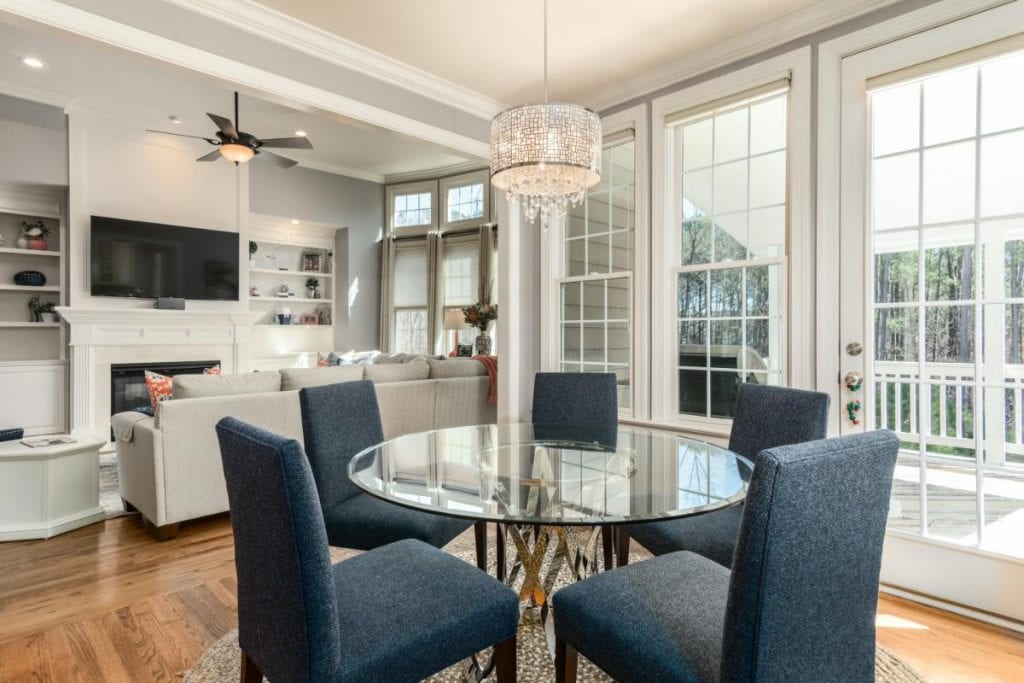If your living room doubles as your dining space, you’re not alone—it’s one of today’s most popular design trends. Combining these areas brings people together and lets your home work smarter, not harder.
But how do you make it feel like one unified space rather than two different rooms squeezed together? Fret not! This article is here to help.
Here, we’ll share some essential design tips—from defining zones to choosing furniture, sizes, and lighting. By the end, you’ll have a space that flows effortlessly, making hosting and daily life a pleasure.
So, without further ado, let’s get started!

Define Your Space
Creating a living-dining area starts with defining each zone. When you know where your living area ends and your dining area begins, your space instantly feels more organized and intentional.
One simple trick is to use rugs. A rug under the dining surface sets it apart visually without adding walls or dividers. You can do the same for the living area.
If rugs aren’t your style, use furniture to guide the flow. A sofa with its back to the dining surface, for instance, subtly marks the two spaces.
Another option is to add shelves or plants to create a gentle boundary without closing off either area. It’ll also make the entire room more comfortable to use every day.
Choose the Right Dining Table and Seating
Your dining table is the heart of this setup, so it needs to feel just right. Beyond style, table dimensions matter a lot in a shared space like this. If it’s too large, it can overwhelm the space. Meanwhile, one that’s too small might look out of place.
And along with the width, getting the right height matters, too. The wrong height can make it feel awkward. For dining, a standard height of around 29 to 30 inches works well.
But if your space or seating calls for something a bit higher or lower, you can always get custom table legs or bases made from online sites. With them, you’re not only getting the exact height you need. But you can also pick from a range of styles and finishes.
Also, remember to choose seating that complements your space. Benches, for example, can be a smart choice if you’re tight on space. Meanwhile, a mix of chairs adds variety without overwhelming.
Harmonize Colors and Materials
Once you’ve chosen your furniture, it’s time to think about colors and materials. The right color palette can make your space feel cohesive without blending everything into one.
Start with a base color—something neutral like gray, beige, or soft white works well. This creates a calm foundation and lets other elements stand out. Add a few accent colors in both areas, like blues, greens, or earthy tones.
When it comes to materials, try to mix and match without clashing. For example, if you have a wooden dining table, balance it with a soft fabric sofa.
A good mix of textures adds depth and keeps the room from looking too one-dimensional.
Go for Multipurpose Furniture
In a shared living-dining space, furniture that does double duty can be a game-changer. Multipurpose pieces let you maximize space and keep things uncluttered.
For instance, a dining bench can easily become extra seating for guests in the living area. Or, consider a console desk that works as a serving station during meals. And as storage for living room essentials for the rest of the time.
Storage ottomans are also a win—they’re great for hiding away blankets, books, or even board games, all while adding a spot to sit.
When each piece has more than one use, you’ll find your space is more functional and flexible for any occasion.
Use Lighting to Set the Ambiance
Lighting is one of the most powerful tools in making a space feel connected yet versatile. With the right lighting, you can create moods that suit relaxed evenings and lively dinners.
Think about your main sources of light. A central ceiling fixture over the dining surface defines that area. Meanwhile, a cozy floor lamp or pendant light can set a welcoming tone in the living area.
For added flexibility, consider dimmable lights. They let you adjust brightness for everything from movie nights to holiday dinners.
Don’t forget natural light—keep windows clear or use light curtains to make the room feel airy and open during the day.
Creating a cohesive living-dining area doesn’t have to be complicated. With the right layout, furniture, colors, and decor, you can make a space that feels as inviting as it is practical. Use these tips to design a multifunctional room that works for family dinners, movie nights, and everything in between.
